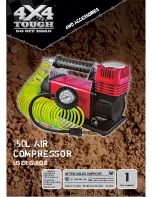
18
GB/IE
Dispose of the old oil at a drop-off point for old oil.
To fill in the correct quantity of oil, make sure that the compres-
sor stands on an even surface. Fill new oil through the oil filler
opening (20) until it comes up to the maximum level. This is
marked with a red dot on the oil level window (18) (Fig. 11).
Do not exceed the maximum filling quantity. Overfilling the
equipment may result in damage. Reinsert the oil sealing plug
(16) into the oil filler opening (20).
11.6 Cleaning the intake filter (Fig. 3, 12, 13)
The intake filter prevents dust and dirt being drawn in. It is
essential to clean this filter after at least every 300 hours in
service. A clogged intake filter will decrease the compressor’s
performance dramatically.
Open the thumb screw (E) to the remove the intake filter.
Then pull off the filter cover (C). Now you can remove the air
filter (F) and the filter housing (D). Carefully tap out the air filter,
filter cover and filter housing. Then blow out these parts with
compressed air (approx. 3 bar) and reinstall in reverse order.
11.7 Storage
m
Important!
Pull out the mains plug and ventilate the equip-
ment and all connected pneumatic tools. Switch off
the compressor and make sure that it is secured in
such a way that it cannot be started up again by
any unauthorized person.
m
Important!
Store the compressor only in a dry location which
is not accessible to unauthorized persons. Always
store upright, never tilted! Oil may leak out!
11.7.1 Releasing excess pressure
Release the excess pressure by switching off the compressor
and using the compressed air which is still left in the pressure
vessel, e.g. with a compressed air tool running in idle mode or
with a blow-out pistol.
12. Transport
Use the handle to transport the compressor.
Observe the weight when lifting the compressor (see Technical
Data).
When transporting the compressor in a motor vehicle, ensure
good load securing.
13. Disposal and recycling
The equipment is supplied in packaging to prevent it from being
damaged in transit. The raw materials in this packaging can
be reused or recycled. The equipment and its accessories are
made of various types of material, such as metal and plastic.
Defective components must be disposed of as special waste.
Ask your dealer or your local council.
The packaging is wholly composed of environment-
ally-friendly materials that can be disposed of at a
local recycling centre.
Contact your local refuse disposal authority for
more details of how to dispose of your worn out
electrical devices.
Old devices must not be disposed of with house-
hold waste!
This symbol indicates that this product must not be dis-
posed of together with domestic waste in compliance
with the Directive (2012/19/EU) pertaining to waste
electrical and electronic equipment (WEEE). This prod-
uct must be disposed of at a designated collection point. This
can occur, for example, by handing it in at an authorised col-
lecting point for the recycling of waste electrical and electronic
equipment. Improper handling of waste equipment may have
negative consequences for the environment and human health
due to potentially hazardous substances that are often con-
tained in electrical and electronic equipment. By properly dis-
posing of this product, you are also contributing to the effective
use of natural resources. You can obtain information on collec-
tion points for waste equipment from your municipal administra-
tion, public waste disposal authority, an authorised body for
the disposal of waste electrical and electronic equipment or
your waste disposal company.
Содержание PKO 500 A2
Страница 4: ...10 11 7 12 13 8 9 B A D E C C D F 15 max min 18 16 20 14 24 G 6 1 25 1 25 13...
Страница 75: ...71...
Страница 77: ......
Страница 79: ......
















































